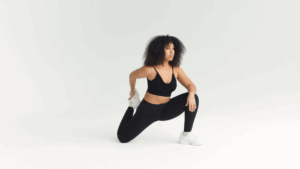
Recovering from pregnancy and childbirth is a journey that requires patience, self-care, and gradual movement. Your body has been through incredible changes, and rebuilding strength and stamina should be done in a way that supports healing rather than rushing back into intense workouts.
Whether you’re a first-time mom or experienced with postpartum recovery, this guide will help you ease back into fitness safely, regain core strength, and boost your energy levels.
Exercise after pregnancy offers many benefits beyond just weight loss. A gradual, well-structured fitness plan can help:
✔ Strengthen weakened muscles (especially core & pelvic floor)
✔ Increase energy levels (reducing postpartum fatigue)
✔ Boost mood & mental health (reducing postpartum depression & anxiety)
✔ Improve posture & mobility (counteracting pregnancy-related changes)
✔ Support overall recovery (helping you feel stronger)
However, the key to postpartum fitness is listening to your body and easing back into movement safely.
The timeline for postpartum exercise varies based on the type of delivery and individual recovery:
➡ Vaginal Birth: Light movement like walking can start within a few days. Structured exercise can begin 4-6 weeks postpartum (with doctor approval).
➡ C-Section Birth: Recovery takes longer, so it’s recommended to wait 6-8 weeks before starting gentle workouts.
📌 Important: Always get clearance from your doctor before beginning a postpartum workout routine!
📽️ Watch Postpartum Walking Tips: Click Here
Pregnancy stretches and weakens the abdominal muscles and pelvic floor. Before jumping into intense workouts, rebuild your core foundation with:
✅ Diaphragmatic Breathing – Helps re-engage deep core muscles.
✅ Pelvic Floor Exercises (Kegels) – Strengthens muscles for better bladder control.
✅ Pelvic Tilts – Gentle movements that help realign the spine.
📽️ Watch Core & Pelvic Floor Exercises: Click Here
Certain exercises can increase the risk of injury and postpartum complications, especially diastasis recti (ab separation) and pelvic floor weakness.
🚫 Avoid high-impact activities like:
⚠ Running
⚠ Jumping (HIIT, burpees)
⚠ Heavy weightlifting
⚠ Traditional crunches & sit-ups
Instead, focus on low-impact strength training, yoga, and Pilates.
📽️ Watch Low-Impact Postpartum Workout: Click Here
After pregnancy, muscles and joints are weakened, so strength training should be gradual and functional.
Here’s a simple Postpartum Strength Routine (No Equipment Needed):
🔹 Glute Bridges (12 reps) – Strengthens core & lower back
🔹 Bodyweight Squats (12 reps) – Improves leg & pelvic strength
🔹 Bent-Over Rows (with light dumbbells, 10 reps) – Strengthens back & shoulders
🔹 Standing Shoulder Press (10 reps) – Helps with upper body strength for carrying baby
🔹 Side-Lying Leg Lifts (10 reps per side) – Engages core & legs
📽️ Watch Beginner Postpartum Strength Workout: Click Here
Pregnancy can weaken posture, leading to back pain and discomfort. Incorporate stretching and mobility work to correct posture:
✔ Cat-Cow Stretch – Relieves back tension
✔ Chest Opener Stretch – Improves posture
✔ Child’s Pose – Helps relax lower back
📽️ Watch Postpartum Mobility Routine: Click Here
Nutrition plays a huge role in postpartum recovery and energy levels.
🥑 Healthy Fats: Avocados, nuts, seeds, olive oil
🍗 Lean Proteins: Chicken, tofu, fish, eggs
🥗 Fiber-Rich Foods: Whole grains, beans, leafy greens
💦 Hydration: Drink at least 8-10 glasses of water daily
📽️ Watch Postpartum Nutrition Tips: Click Here
💡 Week 1-2: Light walking, deep breathing exercises.
💡 Week 3-4: Gentle core & pelvic floor exercises.
💡 Week 5-6: Add bodyweight strength exercises & yoga.
💡 Week 7+ (Doctor Approved): Gradually increase intensity, adding strength training & cardio.
Recovering from childbirth takes time, patience, and a gentle approach. Whether you’re working towards strength, energy, or confidence, following a structured postpartum fitness plan can help you feel strong and empowered.
💬 What helped you feel strong after pregnancy? Share your tips below! 😊
Most women can start gentle movement within 1-2 weeks, but wait 4-6 weeks for structured workouts. Always check with your doctor.
Focus on core & pelvic floor exercises first, then add strength training & walking.
Yes, but weight loss should be gradual to avoid affecting milk supply.
If you notice ab separation or a bulging tummy, consult a pelvic floor specialist before doing core workouts.

Tired of your old gym bag? Discover the best cute, stylish, and functional gym bags for women. From chic totes to versatile backpacks with shoe compartments, find the perfect bag to take you from workout to weekend in style.

Feeling bloated or hormonally imbalanced? Your gut may hold the key. Discover the best fermented foods for women’s health, how they improve digestion, mood, and hormonal balance, and how to easily add them to your diet.

Want to build strong, sculpted legs quickly? Discover the most effective compound exercises for women that target multiple leg muscles simultaneously for faster growth and a powerful lower body. Say hello to leg day gains!

Upgrade your morning with the ultimate high-protein breakfast bagel! This recipe stacks a toasted bagel with a cheesy cottage cheese egg scramble, savory sausage, and creamy avocado for over 40g of protein.

Feeling stressed and your budget is tight? Discover practical and affordable self-care ideas designed for women. Learn how to nourish your mind, body, and soul without spending a dime (or very little!).

Ditch boring breakfasts! Make this high-protein Cheesy Spinach & Egg White Quesadilla in under 10 minutes. A healthy, delicious, and easy way to fuel your busy morning.
© Custom Curves the Fitness Blog 2024